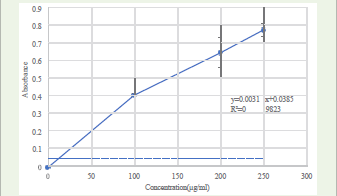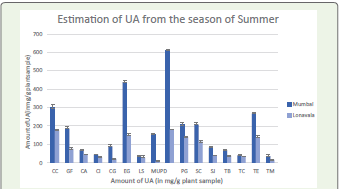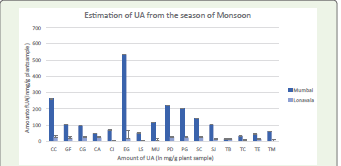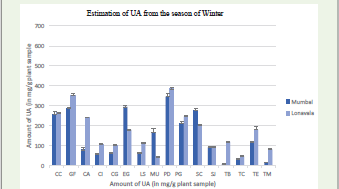Research Article
Quantification of Ursolic Acid from Different Geographical Locations in Order Myrtales
Nidhi Pathak1* and Anil Avhad2
Department of Botany, Plant Biotechnology Laboratory, Ramniranjan Jhunjhunwala College, Ghatkopar (west), Mumbai, India
*Corresponding author: Nidhi Pathak, Department of Botany, Plant Biotechnology Laboratory, Ramniranjan Jhunjhunwala college, Ghatkopar (west), Mumbai, India. E-mail id: pathaknidhi932087@gmail.com
Copyright: © Pathak N, et al. 2023. This is an open-access article distributed under the Creative Commons Attribution License, which permits unrestricted use, distribution, and reproduction in any medium, provided the original work is properly cited.
Article Information: Submission: 07/10/2023; Accepted: 31/10/2023; Published: 06/11/2023
Abstract
Order Myrtales represents homogenous complexes of different chemical composition. Enormous bioactive compounds are believed to be significantly present in the different plant families which are proved to be potential for pharmaceutical uses. Once such notable active compound identified in the current
research is Ursolic acid from the members of order Myrtales. Ursolic acid a pentacyclic terpenoid contributes to a wide range of pharmaceutical properties. In the current study 16 sample of healthy plants were collected from the different geographical regions of Maharashtra i.e., Mumbai (18.9781154°N 72.8367457°E) and Lonavala (18.7557°N,73.4091°E) in different seasons. The identification and quantification of Ursolic acid was carried out using spectrophotometric analysis.
Keywords: Myrtales; UrsolicAcid; Spectrophotometer; Bioactive Molecule; Maharashtra
Introduction
Identification of bioactive molecules in plants has laid down
the foundation of modern therapeutic agents for the treatment of
different health aliments in humans. Secondary metabolites play
significant role in the physiological and biological functions in [1]
A quality information of these significant chemicals can lead to
the betterunderstanding of its therapeutic utility. With an advent
of modernization, role of primarymetabolites has been better
understood in development of plants, right from cell division,growth,
respiration, and reproduction with various interlinked processes
such as the Kerbscycle or citric acid cycle, glycolysis, photosynthesis,
and associated pathways [2]“Secondary metabolites ”or“ Natural
products” are produce dinascarce amount, and serve as main
contributor of odours, tastes, and colours in plant, they are also
identified as a key components of active defence mechanisms against
various pest and plant pathogen.[3]The secondary metabolites are
broadly classified into five main groups viz. Alkaloids, Flavonoids,
Glycosides, Polyphenols and Terpenoids.
Terpenoids are one of the largest classes of natural products
constitute incredible chemicaldiversity. Ursolic acid (3β-hydroxyurs-
12-ene-28-oic acid, UA,) a pentacyclic terpenoidcontributes
to a wide range of pharmaceutical properties [4] It’s a secondary
metabolite present in a wide variety of plants in the form of a free
acid and a glycone of triterpenesaponins chemically also known as
merotine. The other synonyms of Ursolic acid are Urson, Prunol,
Micromerol and Malol. [5] The natural source to Ursolic acid is stem
bark, leaves, or fruit peel. The percentage composition of Ursolic acid
might differ in different species, due to varying presence of enzymes
responsible for synthesis.
The records of Ursolic acid from the natural sources are
documented in the peel of Apple (Malus domestica), Marjoram
(Origanummajorana) leaves, Oregano (Origanumvulgare) leaves,
Rosemary (Rosmarinus officinalis) leaves, Sage (Salvia officinalis)
leaves, Thyme (Thymus vulgaris) leaves, lavender (Lavandula
angustifolia) leaves and flowers, Eucalyptus (Eucalyptus) leaves
and bark, black elder (Sambucus nigra) leaves and bark, hawthorn
(Crataegus spp.) [4,6] Besides the above-mentioned plant species
many other plants might carry potential.
Quantity of UA. It consists of several pharmacological properties
and modulates numerous signaling pathways counteract on chronic
diseases. It also exhibits thermogenic anti-carcinogenic, anti-diabetic,
antioxidant, anti-obesity, anti inflammatory, neuroprotective,
hepatoprotective, and cardioprotective effects. The active
mechanism of UA may involve nuclear factor- kappa B (NF-kB)
and apoptoticsignaling in cancer cells, Marker expression in cardiac
damage, insulin signaling in adipose tissue, inflammation, and the
level of antioxidants in the brain, metabolic signaling and oxidants
level in the liver, and atrophy signaling and metabolic signaling in
skeletal muscles [1].
Finding a novel compounds (secondary metabolites or
phytochemicals) from the plants isan achievement towards
eliminating various human diseases [7] These Phyto-chemical
analyses are invaluable tools for taxonomic differentiation within
species, or for evaluating environmental factors affecting the presence
of metabolites or variation in the biosynthesis of these metabolites
[8,7] These metabolites in the form of biomarkers are widely used in
medicine, biology, ecology,taxonomy and environmental chemistry
due to its ability to cure certain diseases such as cancer, coronary
heart disease [9].
The current study focuses on Ursolic acid (UA), a pentacyclic
terpenoids with wide rangeof pharmaceutical importance [4] The
presence of UA is widely documented in higher plants namely
Oscimum sanctum L.,Vaccinum myrtillus L., Harpagophytum
procumbens DC., Sambucus nigra L., Mentha piperita L., Lavandula
augustifolia Mill, Origanum vulgare L., Thymus vulgaris L. Crataegus
laevigata (Poir) DC, Prunus laurocerasus L., Arctostaphylos uvaursi.,
Coffea arabica., Eucalyptus spp., Malusdomestica, Melissa officinalis
Nerium oleander, Plantago major, Rosmarinus officinalis [5]. The
selection of marker compounds is based on certain factors, including
value in identification of botanical source, significance in therapeutic
or health relevance, availability of analytical methods and standards,
ease of analysis, use as an indicator of quality and stability, and many
more(American herbal products association 2001). These markers are
also known as a valuable tool for fundamental and applied research
[10].
Plants biological components selectively absorbs certain
wavelength of light while reflecting others [11]. Concentration
of various compound scan be determined by spectrophotometric
method, a classical method at the same time the simplest way of
identifying major compounds in the mixture. Identification of
compounds solely based on absorbance however represents strong
limitations. Overlapping of absorbance band of the compounds
presents complicates the estimation of individual compound
concentration. The current study on quantification of Ursolic acid
was carried out using Spectrophotometric Analysis.
Materials and Methods
Preparation of Methanolic extracts:
Methanolic solutions were prepared by weighing about 0.1g of
dried leaves powder in 10ml of Methanol, refluxed on boiling water
bath at 600c for 1 hour. The extract was filtered using Whatman filter
paper 41. The fresh filtrate was used for further analysis.Preparation of standards:
Stock solutions of Ursolic acid was prepared by dissolving1mg
in1mL of methanol (final concentration mg/ml). A standard graph
was prepared, considering series of dilutionsrangingfrom 100 mcg
–500 mcg.Estimation of Ursolic acid [12]:
A volume of 200 μl methanolic solution was transferred in a test
tube and was evaporated to dryness in a boiling water bath. A volume
of 0.3 ml of 5% vanillin glacial acetic acid and 1ml of perchloric acid
solution were added to the tube. The sample solutions were heated
at 60˚C for 45 min and cooled under the tap water. To this cooled
solution, a volume5ml of glacial acetic acid was added. The reaction
mixture was uniformly mixed using thevortex mixture. The Optical
density of the samples was measured at 544 nm on JASCO model
V-530spectrophotometer, one of the most versatile economical and
reliable instruments for UV/Visible.Results
The optimized UV – Spectrophotometric method was used
for the estimation of Ursolicacid, 16 different plant samples were
considered under study using standard equivalence. Stock solutions
of Ursolic acid was prepared by dissolving 1 mg/1 mL of methanol.
Astandard dilution series were prepared ranging from 100 mcg – 500
mcg. The graph wasplotted corresponding absorbance of Ursolic acid
(Y-Axis) and concentration of Ursolic acid (X-axis). Thus, the graph
represents line ar response between 100 μg/ml concentrations to 250
μg/ml with a linear regression of 0.9823.
Where, CC-Callistemon citrinus, GF-Getonia floribunda,
CI-Combretum indicum, CG-Couroupitaguanensis, EG-Eucalyptusglobulus,
LS-Lagerstroemiaspeciosa, MU-Memecylonumbellatum,
PD-Pimentadioica, PG-Psidiumguajava, SC-Syzygiumcumini, SJSyzygiumjambos,
TB-Terminaliabellirica, TC-Terminaliacatappa,
TE-Terminaliacrenulata, TM-Terminalia mantaly.
Conclusion
In the level of secondary metabolites observed in the study,
this might be due the influence of environmental, geographical,
seasonal or interaction with another organism etc.The content and
composition of effective components,i.e.,the secondary metabolites in
medicinal plants are vary with changes in the growth seasons, growth
years and environment, increases or decreases under developmental
process or stress conditions. (Ranaetal., 2020) [13]. Ursolic acid (UA)
is a promising triterpenoid compound present in several parts of
plants. The compound shows abroad range of pharmaceutical
properties and therapeutic effects and exhibit thermogenic effects
anti-carcinogenic, anti-diabetic, antioxidant, antiobesity, antiinflammatory,
neuroprotective, hepatoprotective, and cardioprotective [1].
The percentage composition of Ursolic acid might differ in
different species, due to the presence of enzymes responsible for
synthesis. The present study summarizes the presence of Ursolic acid
from the plant sample collected in winter (Mumbai) and in summer
(Lonavala) are adequate.




